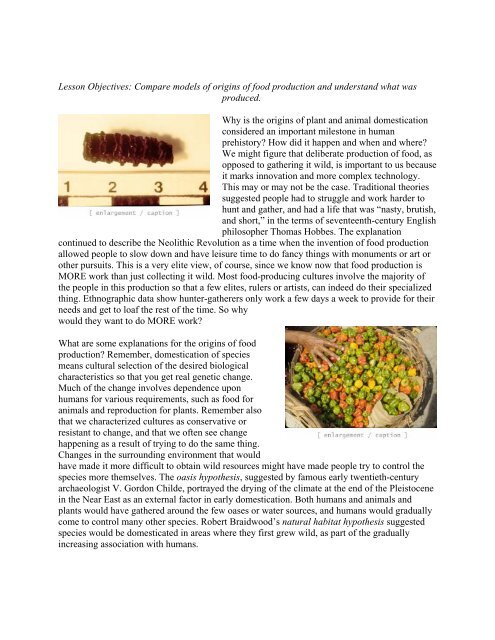INTRODUCTION TO ARCHAEOLOGY Nancy White - Touro Institute
INTRODUCTION TO ARCHAEOLOGY Nancy White - Touro Institute
INTRODUCTION TO ARCHAEOLOGY Nancy White - Touro Institute
You also want an ePaper? Increase the reach of your titles
YUMPU automatically turns print PDFs into web optimized ePapers that Google loves.
Lesson Objectives: Compare models of origins of food production and understand what was<br />
produced.<br />
Why is the origins of plant and animal domestication<br />
considered an important milestone in human<br />
prehistory? How did it happen and when and where?<br />
We might figure that deliberate production of food, as<br />
opposed to gathering it wild, is important to us because<br />
it marks innovation and more complex technology.<br />
This may or may not be the case. Traditional theories<br />
suggested people had to struggle and work harder to<br />
hunt and gather, and had a life that was “nasty, brutish,<br />
and short,” in the terms of seventeenth-century English<br />
philosopher Thomas Hobbes. The explanation<br />
continued to describe the Neolithic Revolution as a time when the invention of food production<br />
allowed people to slow down and have leisure time to do fancy things with monuments or art or<br />
other pursuits. This is a very elite view, of course, since we know now that food production is<br />
MORE work than just collecting it wild. Most food-producing cultures involve the majority of<br />
the people in this production so that a few elites, rulers or artists, can indeed do their specialized<br />
thing. Ethnographic data show hunter-gatherers only work a few days a week to provide for their<br />
needs and get to loaf the rest of the time. So why<br />
would they want to do MORE work?<br />
What are some explanations for the origins of food<br />
production? Remember, domestication of species<br />
means cultural selection of the desired biological<br />
characteristics so that you get real genetic change.<br />
Much of the change involves dependence upon<br />
humans for various requirements, such as food for<br />
animals and reproduction for plants. Remember also<br />
that we characterized cultures as conservative or<br />
resistant to change, and that we often see change<br />
happening as a result of trying to do the same thing.<br />
Changes in the surrounding environment that would<br />
have made it more difficult to obtain wild resources might have made people try to control the<br />
species more themselves. The oasis hypothesis, suggested by famous early twentieth-century<br />
archaeologist V. Gordon Childe, portrayed the drying of the climate at the end of the Pleistocene<br />
in the Near East as an external factor in early domestication. Both humans and animals and<br />
plants would have gathered around the few oases or water sources, and humans would gradually<br />
come to control many other species. Robert Braidwood’s natural habitat hypothesis suggested<br />
species would be domesticated in areas where they first grew wild, as part of the gradually<br />
increasing association with humans.
















